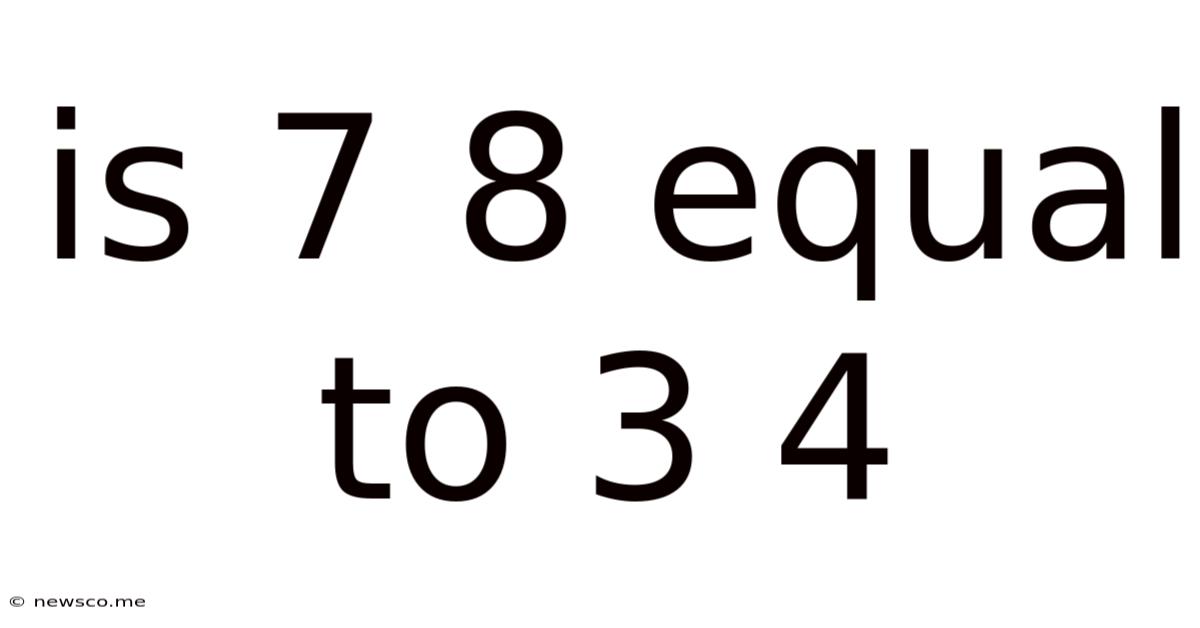Is 7 8 Equal To 3 4
News Co
May 07, 2025 · 5 min read

Table of Contents
Is 7/8 Equal to 3/4? A Deep Dive into Fraction Equivalence
The question, "Is 7/8 equal to 3/4?" is a seemingly simple one, perfect for elementary school math. However, understanding the underlying concepts of fraction equivalence goes far beyond a simple yes or no answer. This article delves into the intricacies of comparing fractions, exploring various methods to determine equivalence, and ultimately answering the initial question definitively. We'll also touch upon practical applications and real-world scenarios where understanding fraction equivalence is crucial.
Understanding Fractions: Numerator and Denominator
Before we tackle the main question, let's establish a firm understanding of what fractions represent. A fraction, in its simplest form, represents a part of a whole. It's composed of two key elements:
- Numerator: The top number in a fraction indicates how many parts we have.
- Denominator: The bottom number represents the total number of equal parts the whole is divided into.
For example, in the fraction 3/4, the numerator (3) tells us we have three parts, and the denominator (4) tells us the whole is divided into four equal parts.
Methods for Comparing Fractions
Several methods exist to compare fractions and determine if they are equivalent. Let's explore the most common ones:
1. Finding a Common Denominator
This is perhaps the most straightforward method. To compare fractions, we convert them to equivalent fractions with the same denominator. This allows for a direct comparison of the numerators.
To find a common denominator for 7/8 and 3/4, we need to find the least common multiple (LCM) of 8 and 4. The LCM of 8 and 4 is 8.
- We leave 7/8 as it is since its denominator is already 8.
- To convert 3/4 to an equivalent fraction with a denominator of 8, we multiply both the numerator and denominator by 2: (3 x 2) / (4 x 2) = 6/8.
Now we can compare 7/8 and 6/8 directly. Since 7 > 6, we conclude that 7/8 is greater than 3/4, not equal to it.
2. Cross-Multiplication
Another efficient method for comparing fractions is cross-multiplication. We multiply the numerator of one fraction by the denominator of the other and vice versa. If the products are equal, the fractions are equivalent. If not, they are not equivalent.
Let's apply this to 7/8 and 3/4:
- 7 x 4 = 28
- 8 x 3 = 24
Since 28 ≠ 24, we conclude that 7/8 is not equal to 3/4.
3. Simplifying Fractions
Sometimes, fractions can be simplified to their lowest terms by dividing both the numerator and denominator by their greatest common divisor (GCD). This can make comparisons easier.
While 7/8 is already in its simplest form (the GCD of 7 and 8 is 1), 3/4 is also in its simplest form (the GCD of 3 and 4 is 1). Simplifying doesn't directly answer the equivalence question in this case, but it's a valuable tool for working with fractions in general.
4. Decimal Conversion
Converting fractions to decimals provides another way to compare them. We divide the numerator by the denominator to obtain the decimal equivalent.
- 7/8 = 0.875
- 3/4 = 0.75
Since 0.875 > 0.75, we confirm that 7/8 is greater than 3/4.
Visual Representation: Understanding the Difference
A visual representation can significantly aid in grasping the concept of fraction equivalence. Imagine two pizzas, both cut into equal slices.
- One pizza is cut into 8 slices, and you have 7 of them (7/8).
- The other pizza is cut into 4 slices, and you have 3 of them (3/4).
Clearly, you have more pizza from the first pizza (7/8) than the second (3/4). This visual representation reinforces the fact that 7/8 is not equal to 3/4.
Practical Applications of Fraction Equivalence
Understanding fraction equivalence is vital in numerous real-world scenarios:
- Cooking and Baking: Following recipes often requires adjusting ingredient amounts based on fractions. Knowing how to find equivalent fractions ensures you maintain the correct proportions.
- Construction and Engineering: Accurate measurements and calculations are paramount in these fields. Fraction equivalence is essential for precise work.
- Finance: Working with percentages, which are essentially fractions (e.g., 25% is equivalent to 1/4), necessitates a strong understanding of fraction equivalence.
- Data Analysis: Representing and comparing data often involves fractions and percentages, making fraction equivalence a crucial skill.
Beyond the Basics: Working with Improper and Mixed Fractions
The examples above used proper fractions (where the numerator is less than the denominator). However, the concepts of fraction equivalence extend to improper fractions (where the numerator is greater than or equal to the denominator) and mixed numbers (a whole number and a fraction).
The methods described above (finding a common denominator, cross-multiplication, decimal conversion) apply equally well to improper fractions and mixed numbers. Remember to convert mixed numbers to improper fractions before applying these methods for consistent results.
Conclusion: 7/8 is NOT Equal to 3/4
Through multiple methods – finding a common denominator, cross-multiplication, decimal conversion, and visual representation – we've definitively shown that 7/8 is not equal to 3/4. In fact, 7/8 is greater than 3/4. This seemingly simple question highlights the importance of understanding the fundamental concepts of fractions and the various techniques used to compare and manipulate them. Mastering these concepts is vital for success in mathematics and its numerous real-world applications. The ability to confidently work with fractions opens doors to more advanced mathematical concepts and problem-solving skills. So, next time you encounter fractions, remember the power of equivalent fractions and the methods available to compare them accurately.
Latest Posts
Related Post
Thank you for visiting our website which covers about Is 7 8 Equal To 3 4 . We hope the information provided has been useful to you. Feel free to contact us if you have any questions or need further assistance. See you next time and don't miss to bookmark.